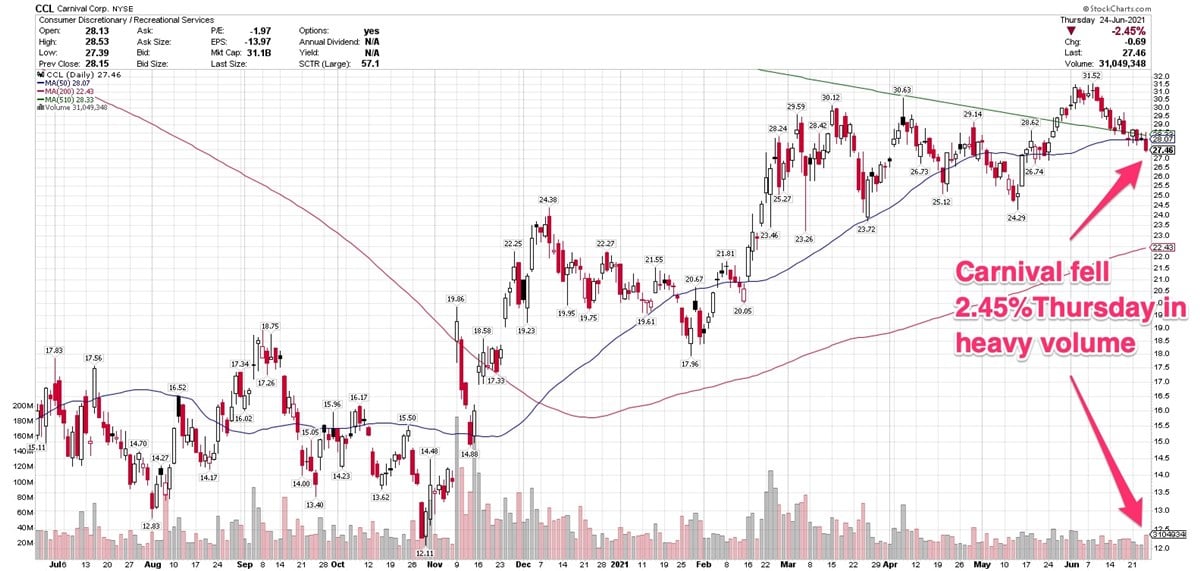Shares of Carnival Cruise Lines are trading lower, despite optimistic signs for the company, which was bettered during the pandemic.
Free Book Preview
Money-Smart Solopreneur
This book gives you the essential guide for easy-to-follow tips and strategies to create more financial success.
June
25, 2021
4 min read
This story originally appeared on MarketBeat
Even as major indexes rallied to new highs, Carnival Cruise Lines (NYSE: CCL) slumped more than 2% after reporting a second-quarter loss of $2 billion.
Cruise lines were among the industries most severely battered by Covid closures last year and early this year.
Could its ongoing progress as many countries reopen be a bellwether for better days to come?
The company gave some optimistic forecasts about the near future. According to Thursday’s release:
- Q2 2021 ended with $9.3 billion of cash and short-term investments, which the company believes is sufficient liquidity to resume full cruise operations.
- Customer deposits increased sequentially in the quarter.
- The monthly average cash burn rate for the first half of 2021 was $500 million, which was better than forecast, mainly due to the timing of proceeds from ship sales and working capital changes.
- 42 ships from eight of the company’s nine brands either have resumed operations or are scheduled to resume operations by the end of November. That tally represents more than 50% of the company’s capacity, with more announcements expected in the coming weeks.
- Cumulative advanced bookings for the full year of 2022 are ahead of a very strong 2019, despite minimal advertising or marketing.
The company’s brands include not only Carnival Cruise Line, Princess Cruises, but also Holland America Line, Seabourn, Costa Cruises, Cunard and others. It also operates Holland America Princess Alaska Tours.
Wednesday, ahead of the earnings announcement, the company said it expects a “full return” for all its services by the summer of next year.
An Early Pandemic Casualty
Carnival’s shares began plummeting in January 2020 as the first reports of Covid began to circulate. However, even then, the stock was well below its all-time high from February 2018.
As you might expect, the downward trajectory only gathered momentum in the ensuing months, plunging 23.13% in February 2020 and 60.64% in March.
As you also might expect, revenue sailed off the proverbial cliff in recent quarters, going from north of $4 billion to less than $26 million.
However, with the market being a forward-looking mechanism, shares of Carnival actually rallied 29.96% year-to-date and 56.39% over the past 12 months.
However, there’s reason to be concerned about the company’s future, which may be why shares didn’t exactly cruise higher after a spate of seemingly good news.
It shouldn’t be a surprise that operating a cruise line is heavily capital intensive. Carnival was highly leveraged before the pandemic, which only exacerbated that situation, as the company needed to take on more debt just to survive.
When the company’s news release mentioned changes in working capital, part of that referred to slashing operating expenses during the pandemic to the tune of $1 billion, as well as reducing capital expenditures.
Restructuring Debt
CEO Arnold Donald also restructured the existing debt. He negotiated with creditors to move debt maturities out further, waive some debt covenants and even exchange some debt for equity. Meanwhile, he was able to raise $10 billion in new equity and debt to keep the company afloat.
Carnival shares closed Thursday at $27.46, down $0.69 or 2.45%. Trading volume was 22% higher than normal, not what you want to see in a selloff, but not unusual when there is company news driving downside trade.
The stock cleared a sloppy consolidation on June 1, passing a buy point above $30.63. However, it began pulling back the week ending June 11, and is now about 10% below that previous buy point, meaning it would have triggered a sell under many trading-system rules.
That means it’s not currently in a buy range. In addition to the technicals not lending themselves to a buy decision, the story and the fundamentals are still wobbly. This is a stock that appears to need a long cruising time to reach fundamental health, and it’s possible the increased debt load will be a problem for the foreseeable future.
Featured Article: What is Forex?




